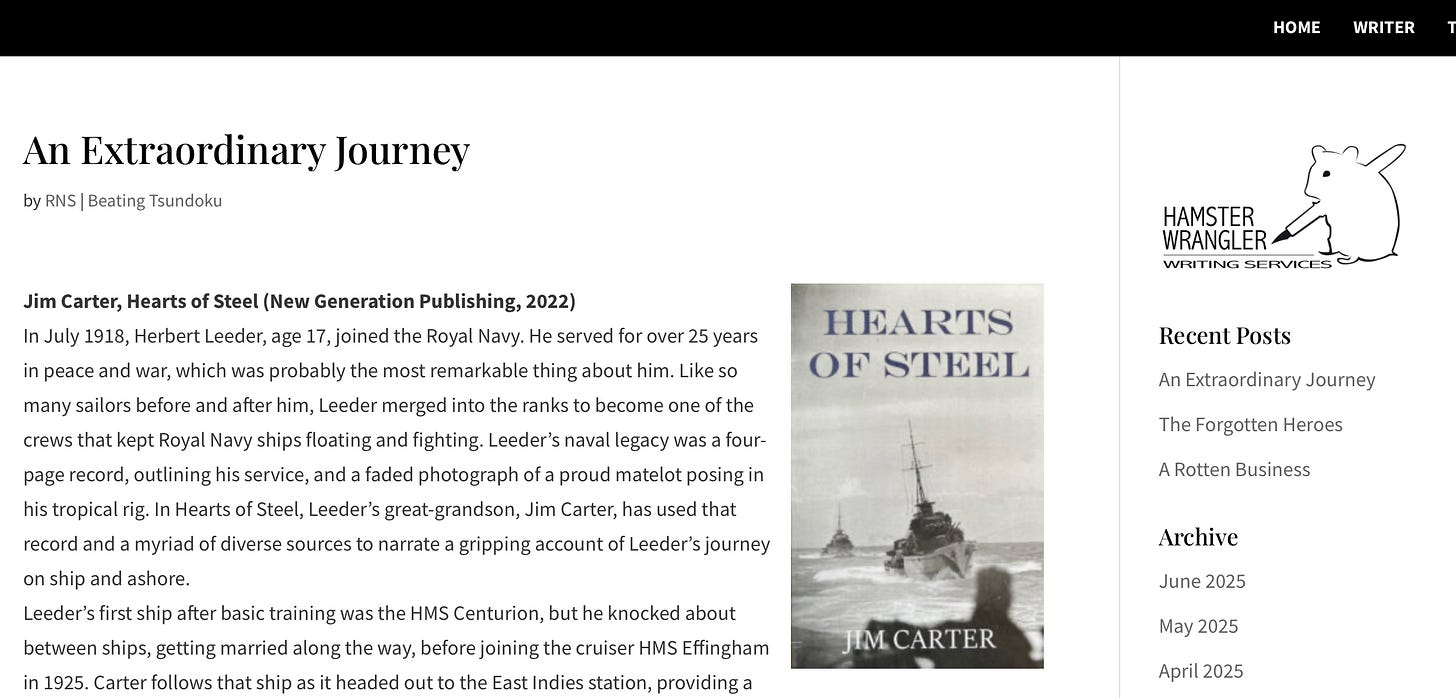Hearts of Steel - Review
An independent review of Hearts of Steel by Robert Neil Smith
It’s quite a nerve wracking experience sending your work off for an independent review, but if all goes well, so rewarding. I’ve had two instances recently. Hearts of Steel found itself in the hands of Sir Jerry Kyd, the first CO of the British Royal Navy’s aircraft carrier HMS Queen Elizabeth, now retired Rear Admiral who resides in Jersey. He wrote back to me, saying ‘Much enjoying your very impressive book. Lots of authenticity through proper research. You have a skill with writing and describing naval history that is all too often badly handled by other authors.’
It was suggested by one of my contacts on LinkedIn (Mark North who is also here on Substack) to send a copy to Robert Neil Smith. I’m really pleased to be able to share his full review with you, here.
Jim Carter, Hearts of Steel (New Generation Publishing, 2022)
In July 1918, Herbert Leeder, age 17, joined the Royal Navy. He served for over 25 years in peace and war, which was probably the most remarkable thing about him. Like so many sailors before and after him, Leeder merged into the ranks to become one of the crews that kept Royal Navy ships floating and fighting. Leeder’s naval legacy was a four-page record, outlining his service, and a faded photograph of a proud matelot posing in his tropical rig. In Hearts of Steel, Leeder’s great-grandson, Jim Carter, has used that record and a myriad of diverse sources to narrate a gripping account of Leeder’s journey on ship and ashore.
Leeder’s first ship after basic training was the HMS Centurion, but he knocked about between ships, getting married along the way, before joining the cruiser HMS Effingham in 1925. Carter follows that ship as it headed out to the East Indies station, providing a narrative of events with detours into descriptions of naval life, including the ‘crossing the line’ ceremony, burial at sea, time ashore, and the effects of weather and illness. Leeder returned to Portsmouth in 1927, where he became more husband than sailor, before joining the HMS Hawkins in 1932 and returning to the East Indies. Carter provides more details of naval life, including fishing from the decks, watching movies, runs ashore, and hunting hippos! Carter sets all that against the context of the gathering clouds of war over Europe. By the time war broke out, Leeder had joined the HMS Nubian, a Tribal Class destroyer; a ‘lucky ship’ whose luck would run out spectacularly in May 1941.
Nubian first saw action as a convoy escort in the North Sea. Then she took part in the ill-fated Norwegian campaign, where the Luftwaffe ruled the skies and tormented Allied naval and ground forces. This was not the last time, the crew of the Nubian would encounter the dreaded Stuka dive-bomber. Carter describes the adjustments made in the wake of Nubian’s Norwegian experience before she headed into the Eastern Mediterranean in May 1940. Nubian again protected convoys, this time to Malta, and helped provide submarine and air assault screens for capital ships, though she also performed missions outside that remit. Carter describes the Mediterranean theatre and the Royal Navy’s major operations against the Italian fleet and air force and the notorious sinking of the French fleet. HMS Nubian re-enters the scene at the Battle of Calabria in July 1940 as protection for HMS Warspite. She also protected HMS Illustrious for the action against the Italian fleet at Taranto. Leeder resurfaces on charges when in Alexandria for Christmas, but he is soon back at sea in the New Year. Carter narrates the Battles of Matapan and Tarigo then the evacuation of Greece and Crete. The latter brought intense air attacks against Royal Navy ships, and Carter discusses the mental pressures this constant warfare inflicted on the crews. Many RN ships were lost, but Nubian had escaped lightly. Then, on 26 May 1941, her luck ran out when a Stuka creeped in and dropped a bomb on Nubian’s stern, ripping it off and killing 15 sailors. Fortunately, Leeder was not one of them, but Nubian was out of the war for over a year, and that is where Carter concludes his story. Leeder was demobbed in September 1945, living for another twenty years as a family man.
Hearts of Steel is an outstanding account of men and ships in peace and war. Jim Carter knows how to tell a story, weaving aspects of creative non-fiction with more traditional narrative history writing methods. While many, if not most, books on the Royal Navy during this time are driven by operational and technical aspects, Carter’s focuses on the human dimension: the officers and men of the Royal Navy and occasionally the enemies trying to kill them. Leeder was one of those men, and while Carter rarely mentions him by name, Leeder is always present – he could be one of the men manning the pom-poms under Stuka attack or part of a damage control party. The trick in this kind of work is to highlight that the subject is not ‘not there’, and Carter pulls that off very well. Carter also builds in seamlessly lots of context, from the great events to snippets and vignettes of naval life that are rarely included in other books with this range, and he integrates his sources into the narrative without too much intrusion. Carter perhaps digresses too far on occasion, provides a bit too much extraneous detail at times, but that is a mere quibble for a book that rattles along and entertains as much as it informs.




